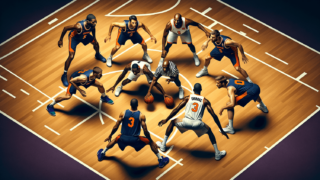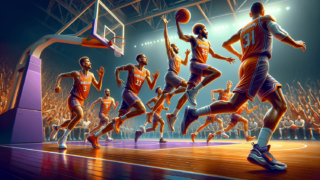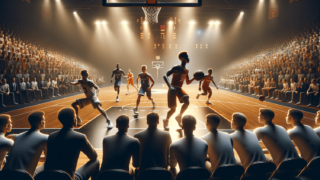
How to Improve Your Basketball Dribbling Speed?
Written by: Basketball Universe
Last updated:

Are you ready to unleash your inner hoops speed demon? Welcome to the ultimate guide on how to increase your basketball dribbling speed, a crucial skill for any player looking to dominate on the court. Whether you’re aiming to blow by defenders or create some ankle-breaking moves, improving your dribbling speed is essential in today’s fast-paced game. So, buckle up and prepare for a fun and professional dive into the techniques, strategies, and tips that will transform your dribbling skills and make you the ultimate ball handler!
How to Improve Your Basketball Dribbling Speed?
To improve your basketball dribbling speed, focus on perfecting your technique, increasing your hand and arm strength, enhancing your court awareness, and practicing dribbling drills regularly. These factors, combined with dedication and consistent practice, will accelerate your progress and make you a quicker dribbler on the court.
Master the Fundamentals of Dribbling
Before you can become a speed demon on the court, you must first master the basics of dribbling. Good technique is vital for efficient and effective ball handling, which will ultimately enhance your dribbling speed.
Proper Stance and Hand Positioning
Begin by focusing on your body position and hand placement. When dribbling, keep a low and athletic stance with a slight bend in the knees and hips. This will help maintain control and balance while allowing for quicker movement. Your hand should be on top of the ball, not on the side, with your fingers spread wide to provide optimal control. A relaxed wrist and a controlled grip will also help maintain smooth dribbling and contribute to faster ball speed.
Pound the Ball
One essential aspect of improving dribbling speed lies in how hard you dribble the ball. Ensure you pound the ball forcefully into the ground while maintaining a controlled grip. Pounding the ball helps improve its bounce speed and prevents defenders from closing in on the ball.
Keep Your Head Up
When players focus too much on the ball during dribbling, they limit their court vision and hinder their dribbling speed. By keeping your head up and eyes forward, you can react more swiftly to your teammates’ movements and assess the defense’s positioning, ultimately becoming a faster and more effective dribbler.
Strengthen Your Hands and Arms
Building strength in your hands and arms is crucial for increasing dribbling speed. A strong and agile ball handler can quickly shift directions and maintain control even in the face of aggressive defense.
Finger Exercises
Finger exercises, such as finger taps or fingertip push-ups, will enhance finger strength and flexibility. Strong fingers are crucial for tightened ball control, making it easier to add some sizzle to your dribbling speed.
Wrist Exercises
Strong wrists allow for faster and more forceful dribbling. Incorporate wrist exercises into your routine, such as wrist curls, wrist extensions, and rubber band exercises. These help improve wrist strength and flexibility, amplifying the force you apply while pounding the ball during dribbling.
Forearm Workouts
Forearm strength is an essential component for faster dribbling. Exercises like farmer’s walks, forearm curls, or forearm extensions can provide the additional power you need to elevate your dribbling speed.
Cultivate Court Awareness
Increasing dribbling speed isn’t merely about physical improvements; developing a greater understanding of the game will help you become a better ball handler. More specifically, sharpening your court awareness can dictate your speed on the court by knowing when and where to move with the ball.
Study the Game
Watching basketball games, either live or recorded, can help you study and better understand the game dynamics. Focusing on the movements of successful point guards or players who excel at dribbling is an excellent way to learn from the best and spotlight areas for personal improvement.
Gain Speed from Strategy
By understanding the strategic aspect of basketball, you can boost your speed by anticipating the opposition’s defense, exploiting their weaknesses, and ultimately making more informed decisions on the court. As you gain experience, your decision-making speed will increase, allowing you to dribble more quickly and with purpose.
Drills to Elevate Your Dribbling Speed
Regular practice is the most critical aspect of improving your dribbling speed. Below are some practical drills that you can incorporate into your practice sessions to become a faster and more skilled dribbler.
Wall Dribbling
Set up near a wall with a basketball in one hand. Begin dribbling the ball against the wall, using only your fingertips while keeping your arm straight. The goal is to reach shoulder height and gradually increase the speed of the dribble. Focus on maintaining control and switch hands after a set time or number of repetitions.
Two-Ball Dribbling
For this drill, you’ll need two basketballs. Begin by dribbling both balls simultaneously, making sure to maintain control and keep your head up. Focus on pound dribbling, ensuring both balls hit the ground at the same time. As your confidence increases, vary the dribbling height or incorporate alternating dribbles to challenge yourself.
Figure-Eight Dribbling
Begin with your legs shoulder-width apart and the basketball in both hands. Dribble the ball in a figure-eight motion around and through both legs. Work on keeping the ball low and controlled while maintaining a low stance throughout the drill. As you become more comfortable, challenge yourself to increase your dribbling speed.
Speed Dribble Relays
Make use of the full basketball court for this drill. Begin on one baseline, and speed dribble to the opposite baseline as quickly as possible while maintaining control. Once you reach the opposite baseline, turn around and dribble back. Repeat this exercise several times, focusing on increasing your speed during each repetition.
Defensive Shadow Dribbling
This drill requires a partner to serve as a shadow defender. Dribble up and down the court using various dribbling moves such as crossovers, behind the back, or between the legs, trying to keep ahead of the defender. The goal is to improve control and speed while under the pressure of an opponent’s close proximity.
Give Yourself Time to Improve
Remember that improving your basketball dribbling speed won’t happen overnight. It requires dedication, consistent practice, and patience. As you continue to work on your technique, strength, and understanding of the game, your skills will gradually improve, and your dribbling speed will ultimately reach new heights.
Embrace the Power of Agility
While enhancing your dribbling speed is essential, working on your overall agility will help you become a more formidable basketball player. Agility entails the ability to change directions quickly while maintaining balance, control, and speed. A player who masters agility will experience improved dribbling and be better equipped to beat defenders on the court.
Agility Ladder Drills
Agility ladder drills are a simple, effective way to sharpen footwork, speed, and fluidity. Incorporate drills like jumps, high knees, lateral steps, and hops into your training routine, focusing on quickness and precision.
Cone Exercises
Set up a series of cones to practice full-speed dribbling, weaving in and out while maintaining control of the ball. Use challenging dribble combinations, such as crossovers, between the legs, and behind the back, focusing on fluid transitions between moves.
Resistance Band Training
Using resistance bands during drills can help improve first-step quickness and overall leg strength. Attach the band to your waist and anchor it to a fixed point or have a partner hold it. Practice dribbling and directional changes against resistance, concentrating on maintaining proper form and speed.
Develop Mental Toughness
Becoming a better basketball player isn’t solely about physical growth – it’s about cultivating mental resilience to overcome challenges that the game presents. Developing mental toughness allows you to adapt and continue growing under pressure, ultimately boosting your dribbling speed and overall performance.
Visualization Techniques
Visualize yourself performing certain dribbling moves or navigating through different game scenarios. This mental rehearsal will help solidify your ability to make split-second decisions and execute moves more confidently.
Overcome Adversity
Rebounding from setbacks and pushing through difficult moments are hallmark qualities of great basketball players. Learn to recognize your mistakes, accept them, and use them as motivation for improvement.
Embrace Competition
Playing against skilled opponents not only tests your dribbling speed but also provides an opportunity to develop your mental toughness. Accepting challenges and growing from competitive experiences will help you become a well-rounded player.
Stay Consistent in Your Training
Consistency is vital for any athlete seeking improvement in their dribbling speed and overall performance. Set realistic goals, design a training schedule, and maintain dedication to achieving those targets.
Set SMART Goals
Implement SMART (Specific, Measurable, Achievable, Relevant, and Time-bound) goals for your training, ensuring your objectives are meaningful and attainable. By setting concrete targets, you can track your progress and maintain focus on skill development.
Modify Training Intensity
Listen to your body and make adjustments in training intensity as needed. While pushing yourself is essential, it’s crucial not to overtrain and risk injury. Adequate rest and recovery periods are vital for long-term success.
Seek Feedback and Support
Don’t be afraid to ask for feedback from coaches, teammates, or other experts. Their insights can help identify areas for improvement and encourage your development as a basketball player. Surrounding yourself with supportive individuals increases your motivation and determination to continue evolving your dribbling speed and skill set.
With these additional mental, physical, and strategic components integrated into your training, you’ll be well on your way to mastering the art of basketball dribbling speed and becoming an unstoppable force on the court.
Frequently Asked Questions
Still curious about improving your basketball dribbling speed? We’ve compiled a list of ten frequently asked questions to provide additional insights and help guide you on your journey to becoming a faster, more skilled dribbler.
1. How long will it take to see improvements in dribbling speed?
Improving dribbling speed varies from person to person and largely depends on factors such as dedication, the consistency of practice, and the player’s initial skill level. With regular training and commitment, noticeable improvements can typically be observed within a few weeks to a few months.
2. Is it necessary to have a basketball coach?
While having a basketball coach can provide valuable guidance and personalized feedback, it’s not mandatory for improving dribbling speed. However, it’s essential to follow structured guidelines, watch instructional videos, or work with experienced players to ensure proper techniques are learned and utilized.
3. How often should I practice to improve my dribbling speed?
For optimal results, aim to practice your dribbling skills at least three to five times per week. Consistency during training sessions is vital for continuous growth and enhancement of overall dribbling speed.
4. Can I play other sports and still improve my dribbling speed?
Absolutely! Engaging in other sports can improve general athleticism and help develop complementary skills, such as quickness, agility, and hand-eye coordination, which are beneficial for basketball dribbling.
5. Do I need any specific equipment for dribbling drills?
Basic equipment like a basketball, an open space or court, and a few cones are usually sufficient for most dribbling drills. More advanced training tools, such as dribbling goggles, resistance bands, and agility ladders, can enhance your practice sessions but aren’t strictly necessary.
6. How can I practice game-like situations to improve my dribbling speed?
Simulate game-like situations by participating in scrimmages, pick-up games, or 1-on-1 drills with defenders. Playing against opponents will prepare you for the pressure and speed of real games, helping to fine-tune your dribbling skills.
7. How can I maintain my dribbling speed during games?
Physical conditioning plays a significant role in maintaining dribbling speed during games. Incorporate cardiovascular training, interval workouts, and strength exercises into your routine, effectively increasing endurance and preventing fatigue on the court.
8. Is it necessary to have a dominant hand for dribbling?
It’s more advantageous to develop ambidextrous dribbling skills. By being proficient in handling the basketball with both hands, you’ll be less predictable and more challenging for defenders to guard, consequently increasing your overall dribbling speed and effectiveness.
9. Can I improve my dribbling speed without access to a basketball court?
Yes, you can practice dribbling drills and strength exercises in any open, flat space such as a driveway, a garage, or a backyard. While a basketball court is ideal, consistent practice in alternative spaces can still yield significant improvements in dribbling speed.
10. How do I know if I’m making progress in increasing my dribbling speed?
Tracking your progress using your initial benchmarks, measuring your improvement during drills, or videotaping your practice sessions can provide valuable insights. Additionally, feedback from coaches, trainers, or teammates can help evaluate your progress and identify areas for further development.
Featured Posts
- No pillar pages found.





